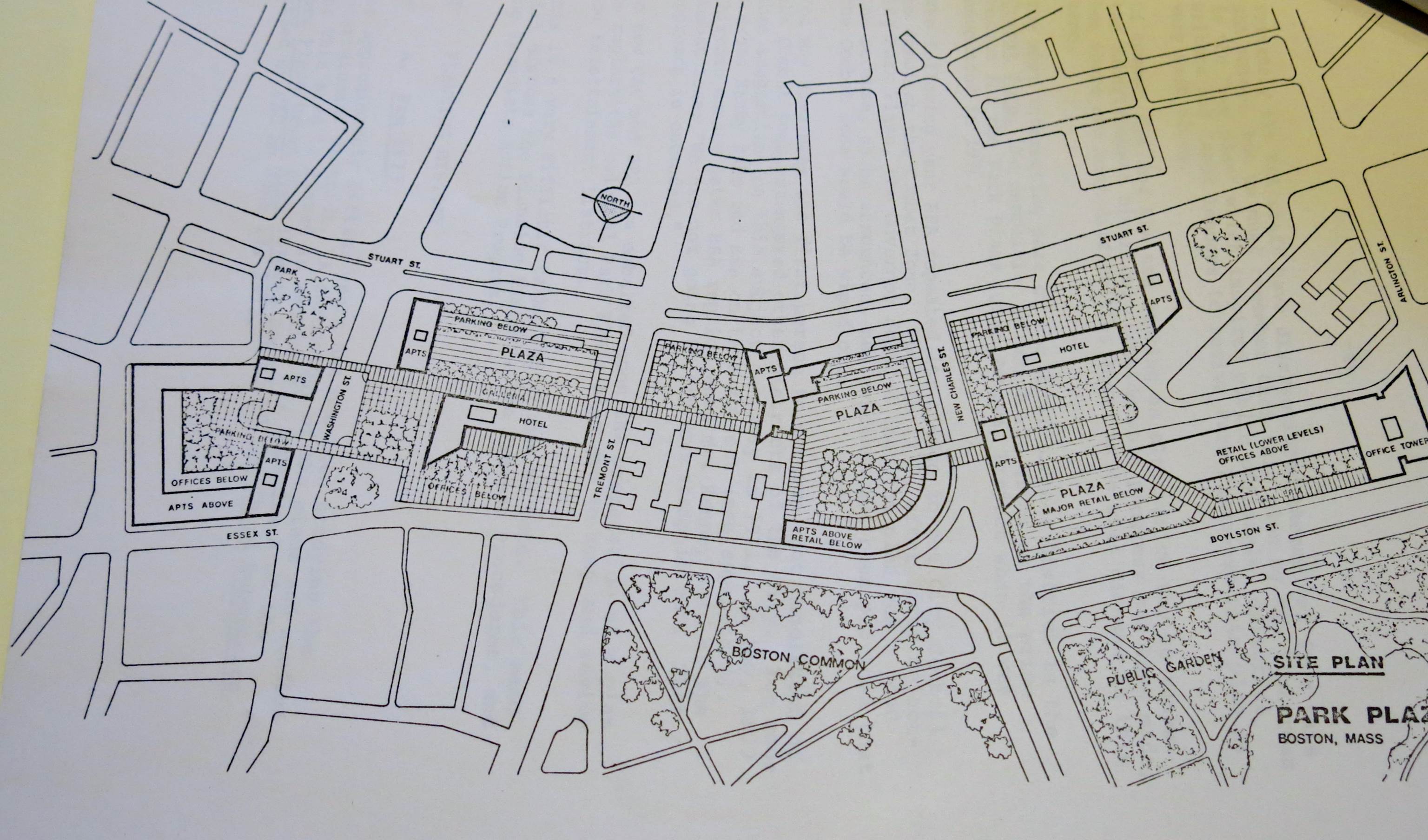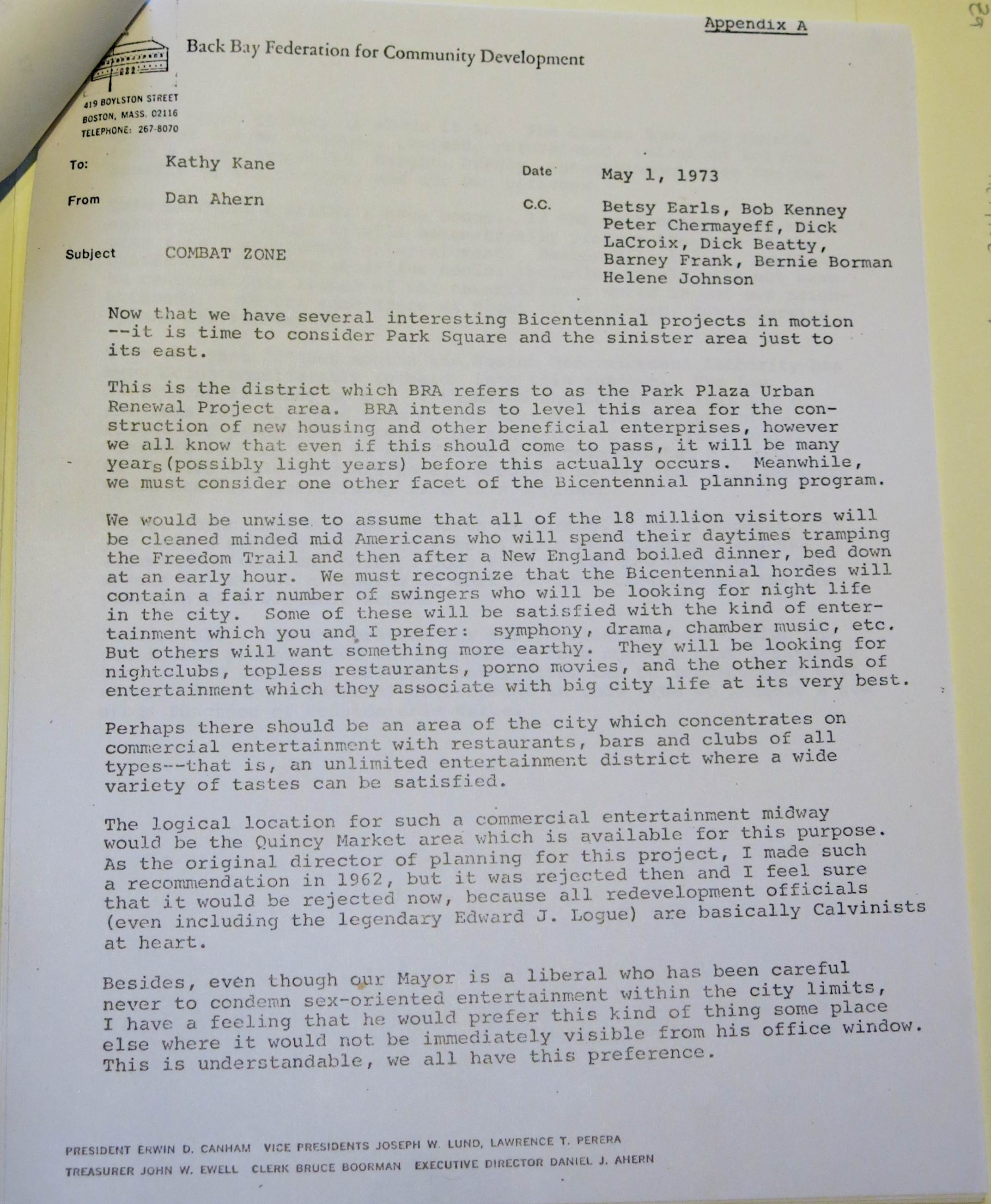By Brendan Kieran, Reader Services
During the 1970s, Boston’s Combat Zone, a (now former) adult entertainment district located around lower Washington Street, was at the center of urban renewal plans. After looking through the finding aid for the Park Plaza Development Project records, I decided to dig in and see if I could unpack attitudes toward the Combat Zone during this period. I largely focused on a group of reports produced during the planning period by the Park Plaza Civic Advisory Committee (CAC), a citizen’s group formed in response to the plans of the Boston Redevelopment Authority (BRA) for the project. These records provide insights into the shifting attitudes toward regulation of adult entertainment and vice in Boston during the 1970s, and also shed some light on the goals of urban renewal projects, the physical and social geography of the city, and desired models for maintaining order in the city.

The BRA’s plans for the Park Plaza project called for the demolition of parts of the Combat Zone. In a May 1973 report, the BRA discusses the impacts of this demolition on adult entertainment in the city. The report mentions the prior demolition of Scollay Square and its impact on adult entertainment. Businesses did not move from the Square to the Washington Street area when it was demolished; rather, the Washington Street adult district already existed. This implies that when the Combat Zone is destroyed, adult businesses from the Washington Street area will not move elsewhere, and the businesses in other areas will not be impacted. The report then states the City of Boston’s desire to increase surveillance and management of “remaining adult entertainment,” utilizing “new street lighting, public mini-parks, sign control, expanded police enforcement, continued police ‘visibility’, and possible additional control under various regulatory measures.”

The “Combat Zone” area is to the left in this photo.
The BRA met resistance to this plan, however. Writing in July 1974, CAC member Daniel J. Ahern criticizes the demolition plan, and writes about proposals to preserve the district. His report represents a different view than the earlier one taken by the BRA; he suggests that containment of adult entertainment in that district is necessary for the well-being of the city. Ahern makes his views on the matter clear in Appendix A of his report, a memo dated 1 May 1973. In the memo, he is very critical of the “earthy” forms of entertainment in the Combat Zone that he thinks certain people “associate with big city life at its very best.” However, he argues that the best approach is to maintain it in that location, invest in it, and keep it available for people who want it while protecting other parts of Boston from those forms of entertainment.
Along these lines, an Entertainment District Subcommittee of the CAC was formed to work on these issues. Connections were formed between the CAC and business owners in the area, who wanted to privately invest in plans for improvements to the area. Additionally, both the CAC and the business owners expressed interest in working with the BRA to implement new plans. The BRA, however, while expressing a willingness to work with the CAC and business owners, was fairly uncooperative. As of Ahern’s writing in July 1974, and at least as late the release of a February 1975 CAC newsletter, the demolition plan was still in place.

These discussions about vice and urban planning took place within a broader context of urban renewal in 1970s Boston. The Park Plaza reports call for revitalization of underutilized areas, and predict an influx of newer, wealthier residents and customers into the area. According to a March 1974 Department of Community Affairs report, over three-quarters of the new housing proposed as part of the Park Plaza project were for “middle and upper income residents.” The influence of big developers and the lack of affordable housing in the proposal serve as points of contention for some people. This suggests room for analysis of class dynamics and who would have benefited from the developments.
As I only looked at this small group of reports, it’s safe to say that I haven’t come close to unpacking the whole story. For example, I’m interested in the roles that race and gender may have played in these discussions and developments. If you’re interested in conducting some investigations of your own, the Park Plaza Development Project records are open for research here in the library at the MHS.

